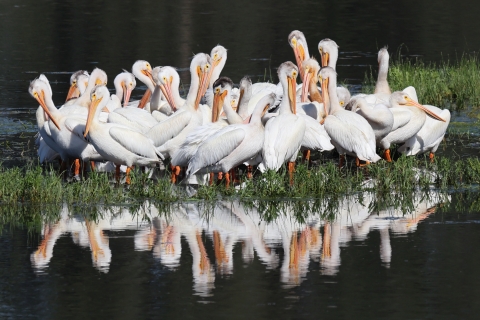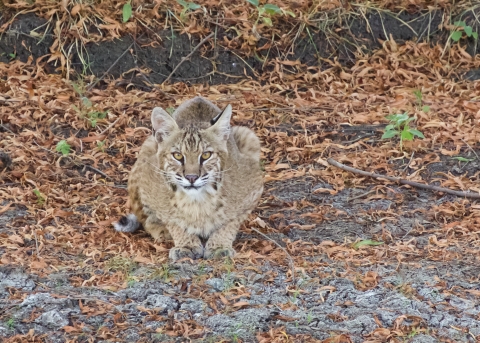Seasons of Wildlife
Here, both the Washita River and Pennington Creek feed the 4,000-acre Cumberland Pool, which is home to several fish species including crappie, sand bass, and channel, flathead and blue catfish. These fish are found within the shallow Cumberland Pool and its seasonally flooded mud flats. This is also important habitat for great blue and green herons and great and snowy egrets. These wading birds can be seen exploring the shallow waters in search of a meal. During spring and fall, thousands of shorebirds can be seen along the lakeshore, while overhead, bald eagles fish the open waters in search of weak or injured birds. In late summer, wading birds like avocets and various sandpipers flock here to feed on food sources exposed by falling water levels.
In addition to the refuge’s nutrient-rich waters, the landscape varies from grasslands to wild plum thickets to oak-hickory-elm woodlands and farm fields planted with crops for wildlife. White-tailed deer emerge by the hundreds from the safety of the forests to join the geese in harvesting the crops planted for wildlife. During summer and spring, the same woods shelter colorful songbirds like painted buntings and summer tanagers that are passing through the refuge or have stopped to nest and raise their young. Spring welcomes the beginning of a significant transition period. As monarch butterflies begin arriving from Mexico on their northerly migration, thousands of migratory shorebirds stop over to feed in refuge wetlands. Migrating warblers, pelicans, hawks and hummingbirds arrive, some stay to nest, while others pass through on their journey north.
Each fall, large flocks of geese choose this refuge as their destination for a winter’s rest before heading north by early March to nest in the tundra. Snow geese, along with thousands of other waterfowl on the Central Flyway, escape the northern freezing temperatures here. They rest in the safety of the upper Washita arm of Lake Texoma and find nourishing food close by. The ducks tend to disperse to feed in lakes and ponds, while snow and Canada geese nibble grains, wing-to-wing in the croplands.
Featured Species
During the spring and summer months, monarch and other butterfly species can be spotted all throughout the refuge. The monarch’s host plant is milkweed and this species can be found along the Prairie Pathways Trail during the summer months. Make sure you take a close look at this plant because there might be some monarch caterpillars feeding on its leaves. Monarchs migrate many miles from the United States and Canada to their annual hibernation spot in central Mexico. Make sure that you grab a butterfly species list at the visitor center before heading out to the trails!
Tishomingo National Wildlife Refuge provides protection for over 290 different species of birds. Some are large and well known such as the bald eagle, Canada goose and American white pelican. Others are small and reclusive like the winter wren, white-eyed vireo and Le Conte’s sparrow. In some drought years, rarities found normally in the western U.S. such as the green-tailed towhee, vermillion flycatcher and Say’s phoebe have shown up here. That is one of the many great things about birds: they adapt with the environment. When their preferred habitat becomes available in a new location, they take advantage of that space and expand their range.
The bald eagle is a spiritual symbol for native people along with being national emblem. Bald eagles can be identified by their broad wingspan while in flight, and by their white head and tail. This species can be frequently spotted from the eagle cove observation tower. Every year the refuge conducts an annual bald eagle survey and have counted as many as 34 individuals here. This species was once endangered by hunting and pesticides, but now the population has recovered while they have been under protection through the Migratory Bird Act.
Snow geese can be spotted by the thousands here at the refuge. You can start to see these migrants in November, and they stay throughout the winter. These flocks are frequently seen feeding on the refuges planted wheat fields. They can also be spotted on the Cumberland pool. Snow geese are a white-bodied bird with black wingtips. Come spring, snow geese migrate back to their breeding grounds in the northern tundra.





